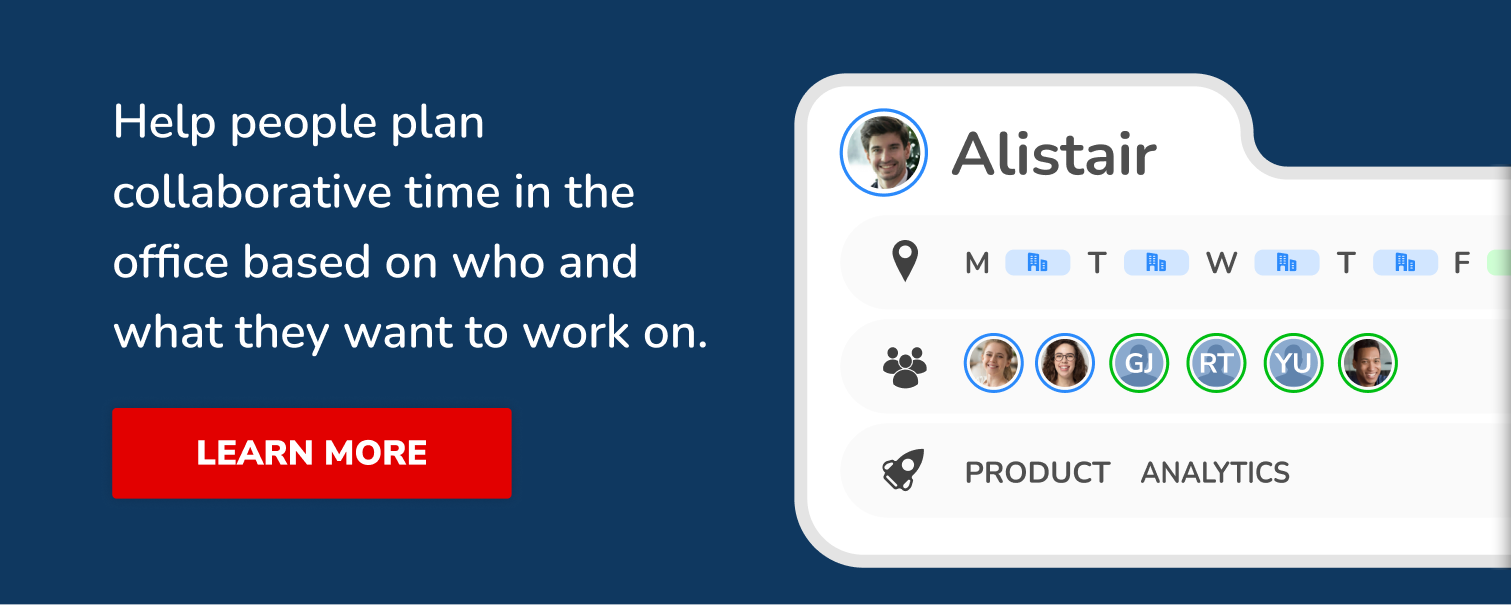Shifting to a hybrid work model can be tricky, trying to organise what days everyone is coming into the office to optimise productivity and in-person meetings is, let’s face it, difficult.
This is why many organisations are opting to introduce structured hybrid work schedules, as a way to find a balance between this new way of working and traditional in-person office jobs.
What Is A Typical Hybrid Work Schedule?
There are different variations, but to fully qualify as a hybrid schedule, it must involve some days working in the office and some days working from home. It’s all part of the hybrid work model.
Apart from that, it’s up for debate on what is the best hybrid work schedule, since what works best for one organisation could be a disaster in another. We’ll take you through the best hybrid work schedules and let you know how to create the perfect schedule for your organisation.
Different Types Of Hybrid Work Schedule Templates
1. Cohort Schedule
The easiest hybrid work schedule to implement is the cohort style. This is when everyone in the organisation comes into the office on a predictable, set schedule. For instance, everyone comes in on Tuesdays and Thursdays.
This works well with larger organisations that have the office real estate space to house everybody simultaneously.
For smaller companies with smaller offices, you could refine it a bit further by the department. The marketing and sales teams come in on Tuesdays and Thursdays, while accounting and finance come in on Wednesdays and Fridays.
This is an easy hybrid schedule because it’s a set-and-forget style. The downside is that it doesn’t give individuals much autonomy or flexibility with their working arrangements. Plus entire parts of the company may never be in the office at the same time which has a big impact on culture and cross functional collaboration.
2. Rotating Schedule
ChurnZero, a software company, use a different hybrid schedule that they’ve nicknamed Rotational Regional Remote or ‘R3’. It works on a rotating schedule that ensures that all employees see other within a six-business day period.
It’s a unique approach and although it doesn’t allow for flexibility from workers, it does mean everyone gets to socialise with each other.
This could help foster a strong company culture, as all employees will get to feel the same sense of belonging, which could increase job satisfaction.

Rotating Hybrid Work Schedule Template
- You’ll need to divide your employees into different letter groups, A, B, C, D and E. E is for employees who want or need to come into the office every day.
- Then you refine the categorizing by also splitting up the company into different departments e.g. Sales & Marketing, Finance, and Other.
- Here’s where the magic happens. A subset of every letter and department group comes into the office on a daily rotating basis.
- So for ChurnZero, they have four-letter groups and three department groups that complete a cycle every 12 business days. As a result, every employee is in the office 50% of the time and sees every single one of their colleagues every six business days.
3. Flexible Schedules
A flexible hybrid work schedule gives a lot more power to the employees, letting them choose when to come in.
Flexible hybrid working models are a much more modern approach to the workplace and have great benefits for employers and employees.
However, they do need a lot more planning involved to ensure that productivity is maximised and everyone knows what everyone else is working on.
Hybrid work scheduling tools can be hugely beneficial for organisations shifting to employee-led flexible scheduling. They provide the up-to-date visibility that's needed when working in a hybrid work environment. You’ll also want a tool that can allow department heads to deal with employee requests or changes in schedules at the last minute.
4. Alternating Schedule
An alternating schedule takes a slightly more fluid approach to hybrid work scheduling than the basic set model or cohort model.
An example of an alternating model would be all employees working in the office two days a week during the winter but only one day a week during the summer.
Or you could alternate days monthly, so have everyone in on Tuesdays and Thursdays for one month, and then switch up the days for the next month.
How To Create A Hybrid Work Schedule
When it comes to creating your own hybrid work schedule, you will first need to do your research. Perform an in-house survey, hold meetings and get feedback from employees on what they would like to see in a hybrid work schedule. Doing your research now will help you find the best fit for your organisation.
Do individuals enjoy coming to the office, are they looking for a place to connect?
Or do your WFH employees appreciate their newfound work-life balance and as a result, love working remotely?
Are there certain tasks that yield much better results when employees are present, like collaborative meetings for example? Do some departments require regular meetings, or can some departments remain remote indefinitely?
All these questions and more should be considered when designing your custom hybrid work schedule. Additionally, there is some great data available about employee preferences like this survey of over 8000 people published in November 2022 by Gallup. It shows that people prefer two or three days in the office per week.
Be Realistic With Scheduling
Once you’ve got your data, it’s time to create your schedule.
In a dream world, it would be great if all hybrid workers had complete flexibility over their schedule, but the reality is a bit different.
Your organisation might inadvertently end up working in silos, with deep divides within departments. This could be due to certain team members forming friendships or collaborating heavily on certain projects and as a result constantly working together to the detriment of the rest of the team.
More worryingly, it could also be due to lifestyle privileges that some workers may have over others. Those who live further away or struggle with childcare arrangements might find it hard to travel to the office on a regular basis.
This is why most hybrid work schedules work better when there is input from leadership on how it’s going to work.
Have a trial period of three months to test out your new hybrid work schedule and don’t be afraid to redesign it if it doesn’t work. It’s far better to fix any issues a few months in versus five years in.

Final Words
A hybrid work schedule truly does offer the best of both worlds, and they are the future of work. Finding the right schedule for you might take a bit of upfront work but your organisation will reap the benefits for years to come, with higher productivity levels and happier staff.
If you’re looking for a hybrid work scheduling tool to help transition your organisation to hybrid work, then DuoMe might be your answer. Learn more.
About Author
Graham Joyce is co-founder of DuoMe, a flexible working advocate and a frequent panellist/commentator on the issues of flexibility or hybrid working.







